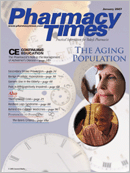Publication
Article
Pharmacy Times
nacds SPEAKS OUT: Specialty Pharmaceuticals on the Rise
Author(s):
We are in a time of transition forcommunity pharmacy as wewitness the rise of specialtypharmaceuticals—medications targetedto chronic and/or rare disease statessuch as cancer, multiple sclerosis, andimmunodeficiency disorders—and theneed for efficient and cost-saving systemsto deliver them. The pipeline ofdrugs currently under review indicates,by sheer numbers, that growth within thespecialty pharmaceutical sector will significantlydrive the overall growth of thepharmaceutical market. This productmixshift will impact all stakeholders,including community pharmacy.
Specialty pharmaceuticals representthe fastest growing segment of the prescriptiondrug market in the UnitedStates, with a projected 20% annualgrowth rate. Typically, these productsare high cost. It is anticipated that by2008, the specialty pharmacy componentwill be >20% of all drug costs,reaching about $73 billion in total dollars.With monthly per patient costsaveraging $1000 to $1500, payers (thegovernment, private employers, andmanaged care organizations) are focusingon ways to effectively manage useof these drugs to realize treatmentpotential, but at a lowered cost that stillensures patients appropriate access.
Despite the complexities of therapies—which require close supervisionand monitoring of the patient, specialhandling, and administrative processes—as well as the costs, the delivery ofspecialty pharmaceuticals has migratedtoward managed care programs. Ifcommunity pharmacy does not becomean integral component of thespecialty pharmaceutical distributionprocess, these products will continueto move through alternate channels.Community pharmacy must respond orrisk losing this market.
Community pharmacy is ideally positionedto care for patients requiring specialtymedications, as the patient educationcomponent of these therapies is criticalto success in treating patients' needs. We need a new paradigm, however,that addresses appropriate ways tomanage the handling and service requirementsof specialty pharmaceuticals,including dispensing, distribution, reimbursement,case management, andother services specific to patients withrare and/or chronic diseases.
By implementing the specialty pharmacymodel, community pharmacy willbe able to provide a mechanism tomanage the cost of specialty pharmaceuticalsfor the patient, an opportunityto save money for the payer, and anothersource of revenue.
To provide a blueprint for this newbusiness model, NACDS has developeda white paper that illustrates how communitypharmacy can be best positionedto participate in specialty pharmacy.The paper identifies operationalrequirements, providing a detailedaccount of implementation steps acommunity pharmacy must undertaketo succeed in this business.
This is an exciting opportunity with significantupside potential for the profession.Community pharmacy must findways to become a provider of specialtypharmacy services and an integral link inthe overall health care system.
Mr. Hannan is serving as presidentand chief executive officer of theNational Association of Chain DrugStores.







